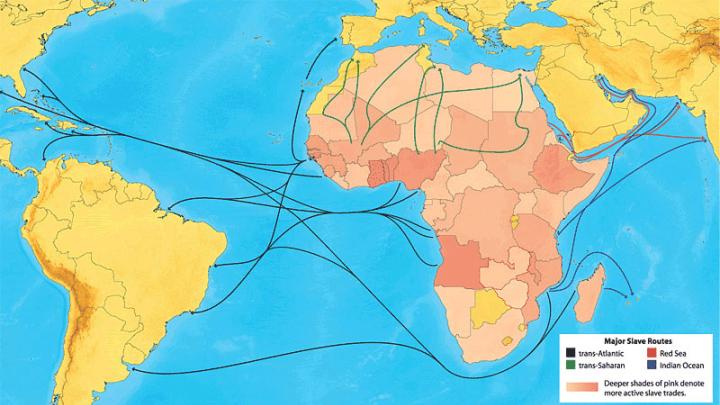For economists who study development, Africa remains a mystery. It’s underdeveloped, but why? Disease? Dictators? Colonial rule? Nathan Nunn, an assistant professor of economics, believes he has found at least a partial answer. The slave trade, far from being a relic of the past, he argues, accounts for much of the continent’s current economic woes.
In a paper published in The Quarterly Journal of Economics, Nunn hypothesized that if the slave trade had negative effects, the countries that were victimized most (for four or five centuries) should show lingering consequences, visible in per capita gross domestic product (GDP) lagging behind their neighbors’. His findings supported his suspicions: the wealthier African nations—such as South Africa, Egypt, and Namibia—had been relatively unscathed, while poorer nations—including Angola, Ethiopia, and Tanzania—lost millions of people.
Establishing a link between slavery and poverty proved difficult. Before he could study the problem with economic models, Nunn needed to delve into the historical records. He relied heavily on a database, built by Emory University historian David Eltis and other researchers (some of whom were at the W.E.B. DuBois Institute at Harvard). The database contained shipping records from the trans-Atlantic slave trade that supplied the Americas with 12 million slaves between 1400 and 1900. But the trans-Atlantic was only one of four trade routes. Records for the trans-Saharan, Red Sea, and Indian Ocean slave trades, which together sent an estimated six million Africans to the Middle East and Asia, were scattered more broadly. To find information on the Indian Ocean route, for example, Nunn traveled to Zanzibar to do research in one of Tanzania’s national archives.
Yet determining how many slaves were taken from Africa was easier than what came next: figuring out the slaves’ ethnicities and what countries their tribes inhabit today. This information was vital because it allowed Nunn to connect historical events to current economic conditions. Shipping records tallied only the number of slaves on each voyage, so he had to look elsewhere to find out whether the slaves had come from the coast or farther inland. Nunn relied on secondary literature that compiled “records of sale, plantation inventories, slave registers, slave runaway notices, court records, prison records, marriage records, death certificates, baptismal records, parish records, notarial records, and slave interviews.” In Zanzibar he studied manumission records, last-minute deeds of freedom given to slaves about to be shipped out of Africa. These documents often included the slave’s original ethnicity. Then, using two ethnographic studies as guides, he superimposed his findings onto a current map of Africa.
His results were clear: most countries with an extensive history of enduring slavers’ predations were worse off than those without. Based on per capita GDP figures for 2000, Nunn estimated further that slavery accounted for up to 47 percent of the income disparity between African nations and the rest of the world. (He says it might account for the entire disparity between African nations and the rest of the developing world.) He also found that the richer an African society had been, the more likely it was to opt into the slave trade. Ironically, an advanced understanding, centuries ago, of credit and monetary systems—which made it easier to engage in this lucrative foreign trade then—led to economic underdevelopment hundreds of years later.
Nunn’s diverse sources have brought in a diverse set of readers, some of them skeptical. The doubters include David Eltis himself, who told the Boston Globe that although he wouldn’t say that Nunn’s research was wrong, it might be premature to draw such bold conclusions. Such conclusions, Nunn replies, are part of his field. “I think economists are willing to make generalizations. That’s basically what our discipline does. I think it’s an issue of, can you generalize across the whole continent?” Nunn believes he can. He has rewritten his paper for the general public; it is scheduled to appear next year in a collection of similarly far-reaching essays edited by Jared Diamond ’58.
The next thing Nunn wants to know is precisely how the slave trade eventually produced poverty. He suspects it may be an issue of trust: Africans sometimes sold other Africans to foreign slave traders. “If your rule of thumb is not to trust anyone because you’ve had a culture that’s evolved in a very insecure environment for 400 years,” he says, “that can persist and lead to bad institutions or bad economic outcomes.”









